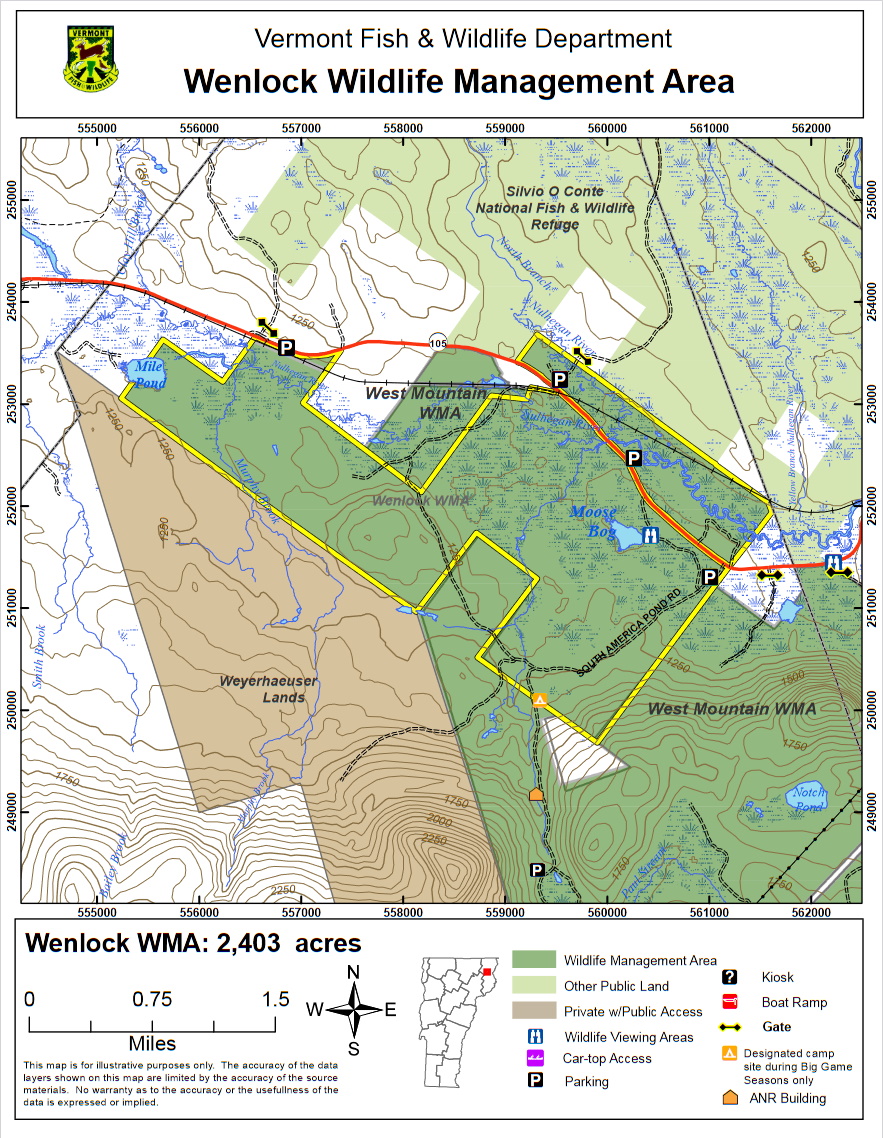Moose Bog, Wenlock WMA
Moose Bog, Wenlock WMA
Island Pond, Vermont 05846
Wenlock Wildlife Management Area guide and mapNulhegan Basin IBA (National Audubon) webpage
Nulhegan Basin IBA map
Tips for Birding
Birdwatching in Vermont, pp. 112-115.
The endless bogs and boreal forests of Wenlock’s vaster neighbors are all present in a tidy, 2,000-acre package at Wenlock Wildlife Management Area. Meander along the easy footpaths that set out from the parking lot and check out the new boardwalk and viewing platform at Moose Bog, with recently improved access for persons with mobility impairments. On a short, easy walk you may see four boreal species: Canada jay, boreal chickadee, black-backed woodpecker, and the state-endangered spruce grouse, (and possibly a fifth: the rusty blackbird, also state endangered).
Tom Berriman's Birding Essex County, Part 2.
Birds of Interest
Wenlock Wildlife Management Area provides a habitat for nesting and migrating waterfowl. Birds use bog ponds, beaver ponds, and the Nulhegan River. Species most commonly seen are ring-necked, black and mallard ducks, hooded mergansers, and Canada geese.
Breeding bird species of particular importance are spruce grouse, black-backed woodpecker, gray jay, and Cape May warbler; all of which breed in only a few other Vermont localities.
Other notable species that may be seen in the WMA are ruffed grouse, wood duck, boreal chickadee, rusty blackbird, yellow-bellied flycatcher, Swainson’s thrush, Tennessee warbler, blackpoll warbler, Lincoln’s sparrow, and white-winged crossbill.
Raptors that utilize the area include goshawk, marsh hawk, sharp-shinned hawk, and barred and great horned owls.
About this Location
The Wenlock Wildlife Management Area encompasses Moose Bog, which has been designed as a “Fragile Area” by the State of Vermont.
About Nulhegan Basin Important Bird Area
See all hotspots at Nulhegan Basin Important Bird Area
This is a large area in the Vermont context; 25,700 acres (40 square miles). It is 21 miles north to south; and 10 miles west to east at the widest. It is the most boreal of Vermont’s landscapes, in large part due to its height above sea level. It has good examples of a variety of boreal ecosystems enhanced by significant topographical relief in spite of no major, tall mountains. The size and shape of the IBA reflect its history of ownership rather than ecological boundaries. Cherished in that part of the state are the expanses of unbroken wildlands notwithstanding the logging history.
The Nulhegan Basin IBA is Vermont’s largest IBA comprising a mosaic of forest and wetland habitat types. The predominance of boreal habitats is typical of forests found further to the north and as such supports a number of species rarely found in Vermont. The IBA is centered around the Nulhegan Basin and stretches from Lewis Pond in the north to the Granby Stream and its tributaries to the south. Included in this area are the Moose, Ferdinand, and the Yellow bogs. Vermont Natural community types include Lowland and Montane Spruce-Fir forests, Northern Hardwood Forest, Spruce-Fir-Tamarack and Black Spruce swamps, Dwarf Shrub, and Black Spruce Woodland bogs and Intermediate Fen.
This IBA includes the Conte National Wildlife Refuge and Wenlock and West Mountain Wildlife Management Areas as well as a number of other state-owned lands. Much of this land was acquired through one of the largest land deals in Vermont. Controversy has revolved around the management of the state lands and access to areas for timber harvesting. Surveys for Spruce Grouse are conducted every 2 years. Other issues include the accidental shooting of Spruce grouse by hunters and invasive species.
Notable Trails
The TrailFinder website has a description and map of a hike at Moose Bog.
Features
Restrooms on site
Wheelchair accessible trail
Entrance fee
Content from Nulhegan Basin IBA (National Audubon) webpage, Vermont’s Best Birding Hotspots by Vermont Agency of Natural Resources, and Ian Worley
Last updated January 22, 2024

